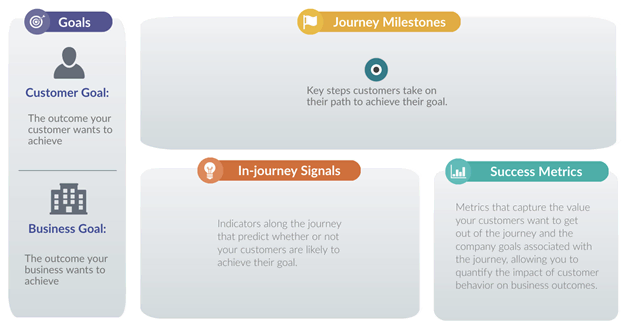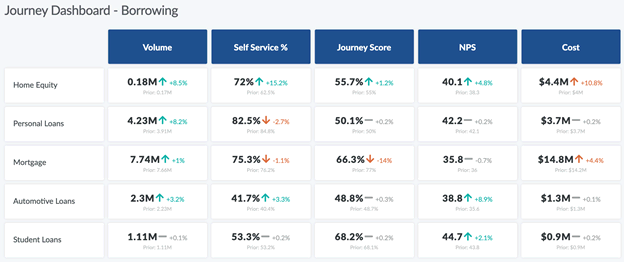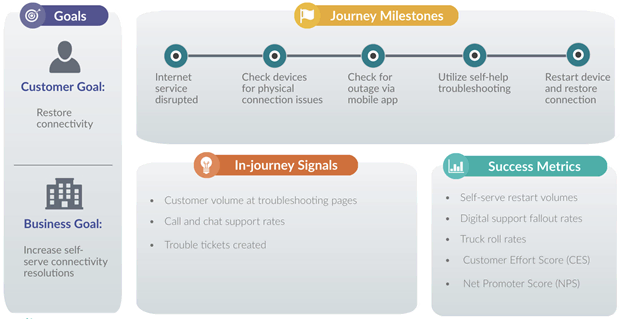Your Genesys Blog Subscription has been confirmed!
Please add genesys@email.genesys.com to your safe sender list to ensure you receive the weekly blog notifications.
Subscribe to our free newsletter and get blog updates in your inbox
Don't Show This Again.

Your customer encounters an issue using her mobile device. She reaches out via social media and then contacts customer service. The agent transfers her to another representative who answers her question. Now, she’s able to use her mobile app to complete her goal.
How are you currently measuring this customer’s experience? Perhaps marketing captures social media engagement, the contact center measures agent transfers and first contact resolution, and the mobile product owner tracks completion rates.
But your customer sees each interaction as one continuous journey to reach her goal. From social media to placing a call to using her mobile app, every moment shapes her overall experience with your enterprise.
You need a better way to measure experiences, prioritize the right opportunities for improvement and deliver the experiences your customers demand. That’s why leading organizations are adopting customer journey measurement.
In this post, we’ll discuss why traditional CX measurement programs fall short, define customer journey measurement and explore how journey measurement enables you to improve CX and achieve business outcomes.
Measuring customer experience with Voice of the Customer (VoC) metrics, such as Net Promoter Score (NPS), is considered a best practice for companies of any size. But it has its limitations.

Let’s dive into three significant reasons why traditional survey feedback and CX measurement approaches fall short.
Survey fatigue is growing. Whether your customers are receiving too many surveys or the surveys themselves are arduous to complete, response rates are dwindling. Fewer and fewer customers respond to your surveys, rendering sample sizes too small and data statistically insignificant.
According to Customer Thermometer, only 9% of customers will actually take the time to thoughtfully respond to your VoC surveys.
While CX and VoC practitioners can devote ample time and resources to optimizing surveys, that time may be better spent improving actual customer experiences. But it’s hard to know where to start if you’re relying on survey feedback too heavily.
Typically, customer feedback is only measured in aggregate, by segment or after isolated transactions at individual touchpoints. This approach fails to capture each customer’s unique context and hinders your ability to:
For example, a retail bank’s website asks clients to rate their experience from one to five after paying their bill online. The website product owner sees ratings decline. She assumes that the bill pay feature on the website needs to be optimized.
But what she doesn’t know is that a majority of clients tried to pay their bill on the mobile app first, but were unable to complete their transaction. They go to the website as a last resort. Paying their bill online is quick and easy, but customers were already frustrated when they got there.
Analyzing feedback in a single channel does not provide an accurate picture of what leads to — or impedes — customers reaching their goals.
You know the feeling. You set a goal to increase customer satisfaction or reduce the effort required by customers in certain channels. You painstakingly optimize interactions to achieve your goal. Your metrics start to improve. You collect feedback and iterate. Then, boom! You hit your goal. You’re proud and maybe a little relieved, too.
But now your CFO approaches you and asks “How much money did you save me?” Or, “How does a 5% increase in CSAT affect share of wallet or average revenue per user?” What do you say?
When it comes to critical business outcomes like revenue, retention and cost to serve, many CX leaders struggle to make the connection. Last year, 41% of companies said they capture improvements in metrics like NPS or satisfaction, but can’t translate that into revenue or costs.
One negative survey response does not indicate that a customer will churn. Multiple positive responses doesn’t mean your customers will stay. CX leaders need a better way to connect customer feedback and behavior to the business metrics that matter most.
Ultimately, NPS and other VoC metrics provide useful data, but they don’t provide enough context to truly identify a CX problem—or solve it. To better measure and improve customer experience by aligning their entire organization around their customers’ experiences, CX leaders are turning to customer journey management.
Unlike interactions, campaigns or process workflows, customer journeys comprise the steps your customers take towards a goal, such as paying a bill, disputing a credit card charge or adding a dependent to a health insurance plan. Customers can take multiple journeys at once and often use multiple touchpoints as they accomplish their goal.
For example, a banking client may have a goal to apply for a mortgage while also attempting to transfer funds from their savings account to their checking account. This client is simultaneously on a Buy journey and a Use journey.
Customer journey management is an approach that enables CX pros to manage, monitor and optimize omnichannel customer journeys by aligning customer goals with business goals. It also facilitates customer journey measurement, which is the practice of measuring end-to-end journeys rather than singular interactions within isolated touchpoints.
Customer journeys help you connect the dots between customer behavior and business outcomes. They allow you to move beyond measuring isolated interactions within single channels to truly understand whether and how your customers are achieving their goals.
It’s crucial to monitor journeys from beginning to end, which will likely include more than one touchpoint. This way, you can track every step your customers take until they achieve their goal and identify any blockers along the way.
For instance, a telecom customer can diagnose and resolve connectivity issues in a number of ways. Typically, wireless providers gauge customer satisfaction with online diagnostic tools or agent-supported channels like live chat or a phone call.
Most customers want to use self-service options to identify and solve their issue on their own. But using a diagnostic tool might not solve your customer’s problem. Sometimes it suffices, but sometimes customers require the help of an agent.
By measuring the entire journey across multiple channels, you will understand:
Customer journey measurement is an approach that enables you to assess and ultimately improve customer experience by monitoring metrics that quantify the success of each customer journey. By measuring journeys more effectively, CX leaders can identify and prioritize opportunities to improve customer experiences.
To effectively measure customer journeys, it’s important to define the customer and business goals for every journey, as well as the milestones, in-journey signals and success metrics.
Each component helps you measure and predict performance, and enables you to quantify the impact of customer behavior on both CX and organizational outcomes.
Let’s define each component:

Customer goal: The outcome your customer wants to achieve.
Business goal: The outcome your business wants to achieve.
Journey milestones: The key (or shared) steps every customer takes on their unique path to achieve their goal.
In-journey signals: KPIs along the journey that predict whether or not your customers are likely to achieve their goal.
Journey success metrics: Metrics that capture the value your customers want to get out of the journey and the company goals associated with the journey, allowing you to quantify the impact of customer behavior on business outcomes.
Remember, each component will vary depending on the journey you are measuring and your business.
To get started with customer journey measurement, it’s best to start small with just a few key journeys and expand your scope over time.
While your measurement program may differ from another business within your industry, the framework in this section provides practical steps you can leverage and tailor to your unique needs, processes and systems.
Here are the four key steps you can take toward establishing a customer journey measurement program:
1. Select Your Proof of Concept Journey
Your customers will take hundreds journeys with your business across their life cycle. From enrolling in a program or purchasing your service to paying a bill and using your product, each journey will begin when your customer has a new need to fulfill and a new goal to accomplish.
Journey-centric organizations typically group customer journeys into six or seven high-priority areas:
As a first step, select an area that aligns with your organization’s goals and priorities. For example, improving support journeys for customers who encounter issues with internet connectivity, enrolling in a care program or disputing a credit card charge.
Successful journey measurement programs are the product of thorough analysis and ruthless prioritization. While you may have hundreds of journeys that roll up into several macro-level journeys, it’s crucial to start small and select a journey that you can actually measure based on the data available to you.
To make the right choice, think about your CX, departmental and overall business goals. Prioritize the metrics that are most important and best capture success.

Next, consider the journeys that you believe impact each goal. Which journeys do you believe would benefit most from measurement and optimization? After all, the overall goal of journey measurement is not just to enhance CX measurement, but to uncover actionable information to improve business outcomes and customer experiences.
Remember, it’s essential to define journeys through an omnichannel lens. For instance, a banking consumer may use multiple touchpoints to dispute a fraudulent charge or use just the mobile app. The goal, and therefore the journey, remain the same.
This means that you’ll measure journeys from start to finish regardless of the channels your customers use to complete their goal, rather than defining them separately for each channel. But don’t worry that you won’t be able to measure or report on the experience within a specific channel. You’ll still be able to drill down and compare the performance of individual channels, as well as find channel-specific issues, at the same time as you start measuring the experience from the customer’s perspective rather than as an internal manager of a single channel.
Now that you’ve selected your proof of concept journey, it’s time to think about the data required to make journey measurement possible.
Customer journey measurement is made easier with a centralized source of customer journey data. While most organizations are drowning in customer data stored in isolated databases, centralized data warehouses and more modern customer data platforms, most lack the integrated time-series data that provides the foundation for journey measurement.
The data required will look different depending on the journey you select and the number of channels your organization supports, e.g. web, chat, voice, mobile, etc. Consider your proof of concept journey and the ways in which your customer can go about achieving their goal. Think about the channels customers may leverage on their journey as well as the internal business units that own those channels.
Let’s examine a common customer journey that any enterprise should measure and improve: bill payment. Most customers will rely on digital channels like your website and mobile app, but some may prefer to make their payment over the phone. Some may use the IVR and others may speak with an agent to complete their payment.
Already, it’s clear that this journey involves data from the billing department, website and mobile team, and the contact center. To measure this journey, you’ll need to collaborate with these teams to access or share their data.
Some enterprises rely on customer journey analytics solutions to aggregate and integrate customer data, making it easier to measure omnichannel journeys in real time. Talk with the data experts within your organization to determine what is possible in the short term. Once you establish and refine your journey measurement program, you can expand your scope over time.
The milestones of a journey represent the steps customers must pass through to reach their goal. Milestones should be channel agnostic, meaning that a customer can reach each milestone regardless of which touchpoints they use. While monitoring channel usage is helpful, it doesn’t help you uncover the goals your customers want to achieve or identify why they’re interacting with specific touchpoints. Defining milestones enables you to easily track progress and measure overall journey performance.
As discussed, in-journey signals capture what customers are actually doing along the journey. These indicators help you assess and predict journey outcomes. This is where including channel or touchpoint interactions is helpful. Switching channels often or dropping out altogether indicates pain points that should be improved to help customers reach their goals.
Using multiple channels and contacting customer service requires more effort from your customer and often increases costs on the business side. It’s essential to capture these signals to determine how likely customers are to complete their journey and the impact their experience has on your success metrics.
Lastly, success metrics can be defined from both your customer’s and organization’s perspective. For your proof of concept journey, it’s best to choose one metric for each. Success metrics for your customer may include NPS, satisfaction or even customer effort (CES). On the business side, consider metrics that impact key outcomes, such as digital containment, self-service rates or cost to serve.
We’ve all gone cross-eyed staring at dashboards full of charts and graphs with an overwhelming amount of numbers and percentages across each. Journey scores are a helpful method to prevent analysis paralysis and to show internal stakeholders how customer journeys are performing at a high level.
A journey performance score should not be the same for all journeys, never mind all businesses. To be truly useful, a journey score should be defined using a combination of metrics that capture your customers’ experience on that journey and the value returned when customers complete it. It’s crucial to monitor the in-journey signals as well as end-of-journey metrics, because even if your customers reach their goals, it may require too much effort to do so.
For example, if a banking client encounters issues when transferring money to their external accounts, they may get frustrated enough to stop making transfers and making transactions altogether. Without monitoring in-journey signals like the number of transfers initiated per month or the number of clients who make a call to complete their transfer, it’s difficult to determine how the Money Transfer journey is truly performing.
Journey scores can be calculated at a micro-journey level and then aggregated up to macro-level journeys to make it easy to monitor overall customer experience, as well as quickly drill down and find the root cause when a macro journey is underperforming. Journey scores also make it easier to socialize your results, which helps you guide your organization’s prioritization and CX improvement efforts.
We’ve all experienced connectivity issues. One minute we’re enjoying the delectable sweetness of The Great British Bake Off and the next, the screen pauses and a buffering circle spins ominously over the piercing blue eyes of Paul Hollywood.
Wireless customers want to stream content, play games and work or learn from home without interruptions. When a problem occurs, they want to restore connectivity as quickly and easily as possible. Service providers want to empower customers to achieve this goal via self-service to minimize both customer effort and cost to service.
With customer and business goals identified, it’s time to define the other components. Consider the milestones, signals and metrics that are most relevant to your consumer and your company.
Support journeys have a major impact on customer satisfaction, as well as internal KPIs such as containment metrics and cost to serve. Including signals and metrics that capture these outcomes will allow you to effectively measure support journeys.

With each component defined, you can create a custom journey score that blends them in a meaningful way.
Adopting a journey-based approach is key to overcoming the challenges many CX leaders face when measuring customer experience.
Customer journey measurement reveals crucial information — such as drop offs, skipped steps, channel switches and more — that will enable you to optimize journeys and orchestrate actions that will improve CX. Not to mention, this level of insight allows CX professionals to make a better business case for future investments by clearly demonstrating the ROI of your initiatives.
Customer journey measurement establishes a direct link between customer behavior and hard metrics like revenue, profitability, churn and customer lifetime value. This way, you can assess the success of each customer journey using the metrics that best capture the value your customers expect and the KPIs your business is measured by. Lear more about how journey measurement can help your organization.
Subscribe to our free newsletter and get blog updates in your inbox.
Related capabilities: